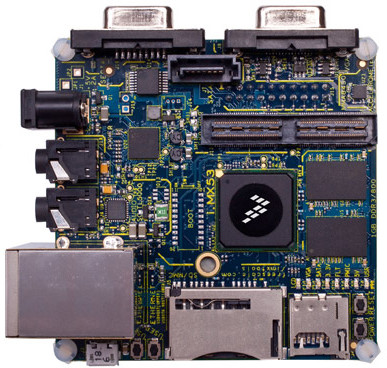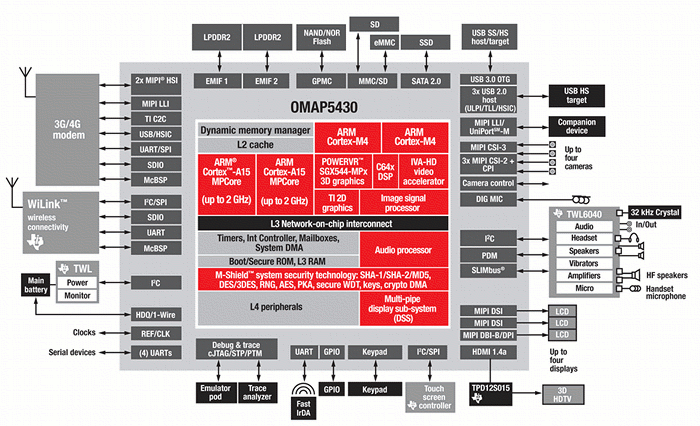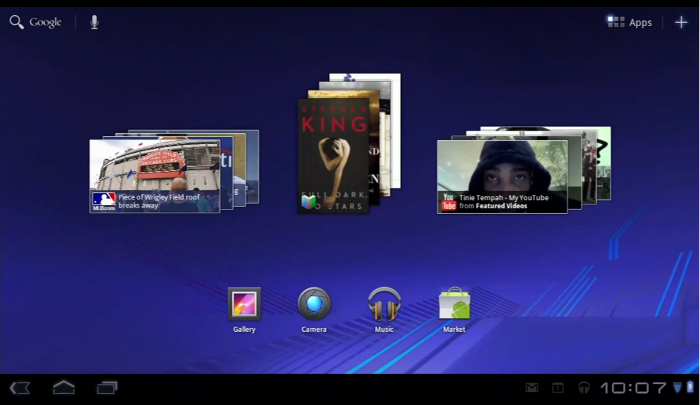Possibly inspired by Texas Instruments low cost Beagleboard (OMAP 3 – 129 USD) and Pandaboard (OMAP4 – 179 USD) and the large following in the development community, Freescale announced its own “Quick Start Development Board” based on i.MX53 for a cost of 149 USD. i.MX53 QSD Board Hardware Description Listed Hardware Features of the i.MX53 Quick Start Development Board: Processor i.MX53 1 GHz ARM Cortex-A8 Processor Power management IC 1 GB DDR3 memory Display LVDS connector VGA connector Parallel LCD add-on card (via expansion connector) HDMI add-on card (via expansion connector) Audio SPDIF output via HDMI add-on card Freescale SGTL5000 audio codec Microphone jack Headphone jack Expansion Connector Enables parallel LCD or HDMI output Camera CSI port signals I2C, SSI, SPI signals Connectivity Full-size SD/MMC card slot microSD card slot 7-pin SATA data connector 10/100 Base-T Ethernet port Two High-Speed USB host ports Micro USB device port Debug JTAG connector […]
Android C/C++ development with Android Native SDK
HyperDevBox is a Japanese based software development company, developing games for Android. They are presenting their new Android game called “Spectral Souls”, the first tactical RPG game for Android. The interesting part is that this Android gamewas not developped with Java, but only using C/C++ programming with Android Native SDK (NDK) (Currently revision 5). Using the NDK means you’ll have to adapt your software to several hardware platform contrary to java development. They now only support Qualcomm and PowerVR GPU for now, and they are working on supporting NVidia Tegra platform and other upcoming GPU. The advantage of native code is a potential performance improvement and code re-use if you have already applications developed in C/C++, the inconvenience is that more work is need to support different hardware. Currently the NDK is only available for ARM platforms (ARMv5TE andARMv7-A), future releases will support x86 instructions. The video below is an […]
Low Cost Android Tablets: Archos Arnova 8 and Arnova 10
Archos – a leader in low cost android tablet with its Archos Gen8 Series (Archos 28/32/48/70/101) – has just released the Arnova Series with the Archos Arnova 8 (149 USD), an 8″ inch Android 2.1 tablet and Archos Arnova A10HT (199 USD), a 10.1″ Android 2.1 tablet. Currently those 2 tablets are based on Rockchip ARM9 RK2818 @ 600 Mhz and use a resistive touchscreen, but in the next few months, they’ll release version with Rockchip RK2918 @ 1GHz (Cortez A8 based), a capacitive touchscreen and Android 2.3 (Gingerbread) for the same price. The firmware of those tablets is apparently not directly supported by Archos, but is developed by a subsidiary in Hong Kong called Arnova (hence the name). Usually the IT (Internet Tablet) series are developed and supported by Archos (better support) and HT (Home Tablet) developed and supported by third parties. Have a look at Charbax’s video of the […]
Linaro Development Board “Snowball” by ST Ericsson
ST Ericsson unveiled a development board based on Nova A9500 (dual ARM Cortex A9 processor and MALI 400 GPU) at MWC 2011 called Snowball (or SKY-S9500-ULP-CXX) for the embedded Linux community and professional developers. This board was designed by CALAO Systems and can be pre-ordered on their website for 200 USD (SKY-S9500-ULP-C11 / Software Development Kit – SDK) or 300 USD (SKY-S9500-ULP-C01 / Production development Kit – PDK). The difference between the SDK and PDK is that the former has no expansion connectors, no battery backup for RTC and only support serial over USB port (for Linux console). First, some pictures with description of the snowball development board. The full documentations for Snowball development board can be found in Calao Systems File Repository, where you’ll get the bottom and top assembly diagrams for both C01 and C11, the major components datasheet, documentation and some photos. The specifications of the boards: – […]
Samsung at MWC 2011: Galaxy Tab 10.1 and Galaxy S 2
Samsung will showcase two highly expected products at Mobile World Congress 2011, in Barcelona: The Galaxy S II smartphone with a 4.3″ Super AMOLED Plus display and dual-core processor and the new Galaxy Tab 10.1 (aka Galaxy Tab 2) with a 10.1″ display (1280×800) running Android 3.0 (Honeycomb). Samsung GALAXY S II Product Specifications are as follows: Network GSM 850/900/1800/1900 HSPA+ 21 850/900/1900/2100 OS Android 2.3 Gingerbread Display 4.27” WVGA (480×800) Super AMOLED Plus Processor ( BB& AP ) 1 GHz Dual Core Application Processor Camera Main(Rear): 8.0-Mega Pixel Camera AF with LED Flash Front: 2.0-Mega Pixel Camera Single Shot, Beauty Shot, , Panorama Shot, Smile Shot, Action Shot, Cartoon Shot Video Codec : MPEG4/ H.264/ H.263/ DivX VC-1 Playback : FULL HD(1080p)@30fps Recording : FULL HD(1080p)@30fps Audio MP3, AAC, AAC+, eACC+ 3.5mm Ear Jack & Speaker, Stereo FM Radio with RDS, Voice Recorder Hub Social Hub – Integrated Contacts, […]
Ziilabs ZMS-05 and ZMS-08 SDK and Development Boards
Ziilabs (originally 3DLABS) is Singapore company, subsidiary of Creative Technology, that provides media application processors for consumers electronics and has offices in the UK, China, USA and Singapore. Ziilabs Media Processors Overview Ziilabs has two media processors: ZMS-05 – A Low Power HD Programmable Media Rich Processor based on two ARM9 core (ARM9-EJS) mainly aimed at smartphones and tablets with the following media capabilities: High compute density SIMD architecture High resolution – decode to 1080p / 720p encode Simultaneous video encode/decode at D1 Wide rage of optimised CODECs and APIs Accelerated OpenGL ES 3D graphics Hardware compositing Advanced image processing 8 GFlops programmable compute ZMS-08 – A HD Media Rich Applications Processor based on an ARM Cortex A8 running @ 1GHz mainly aimed at media players, set-top boxes and digital signage solutions with the following media capabilities: Blu-ray Quality 1080p H.264 Video Decode 1080p H.264 Video Encode 720p H.264 Video […]
Texas Instruments OMAP 5 based on ARM Cortex A15 Core
Texas Instruments announced its new generation of mobile chips OMAP 5 based on the latest ARM core Cortex A15. Press release excerpt: DALLAS (Feb. 7, 2011) /PRNewswire/ — Texas Instruments Incorporated (TI) (NYSE: TXN) announced today the next generation of its popular OMAP™ family: the OMAP 5 mobile applications platform, which is positioned to transform how mobile devices, such as Smartphones, tablets and other mobile form factors are used, making them even more valuable in our daily lives. … The 28 nanometer OMAP 5 applications processors carry on the OMAP family tradition of delivering significant increases in performance and functionality, while lowering power consumption compared to their predecessors. Specifically, they offer up to 3x processing performance and five-fold 3D graphics improvement, yet provide a nearly 60 percent average power reduction compared to a sample user experience on the OMAP 4 platform. Additionally, the OMAP 5 platform’s software is designed for […]
Android Event: Android 3.0 Presentation and MarketPlace Update
Google Android Event on the 2nd of February 2011 was divided into two part a demo about Android 3.0 (Honeycomb) features on Motorola Xoom (First 30 minutes) and an update on Android market place with the new Android market Webstore. The full event (below) lasts for around 53 minutes. If you are in a hurry, you can check the summary under the video and screenshots. During the Android 3.0 presentation, they showcased some of the platform new features such as the multitask button (e.g. to show recent apps), the grid widget, the stack widget and the new notifications mechanism. They also demo’ed backward compatibility of older apps development for Android 2.x by playing Fruit Ninja game. Then the used Gmail app to show the new features of the application framework suh as fragments, drag and drop and the application bar. They spent a fair amount of time boasting 2D and […]








